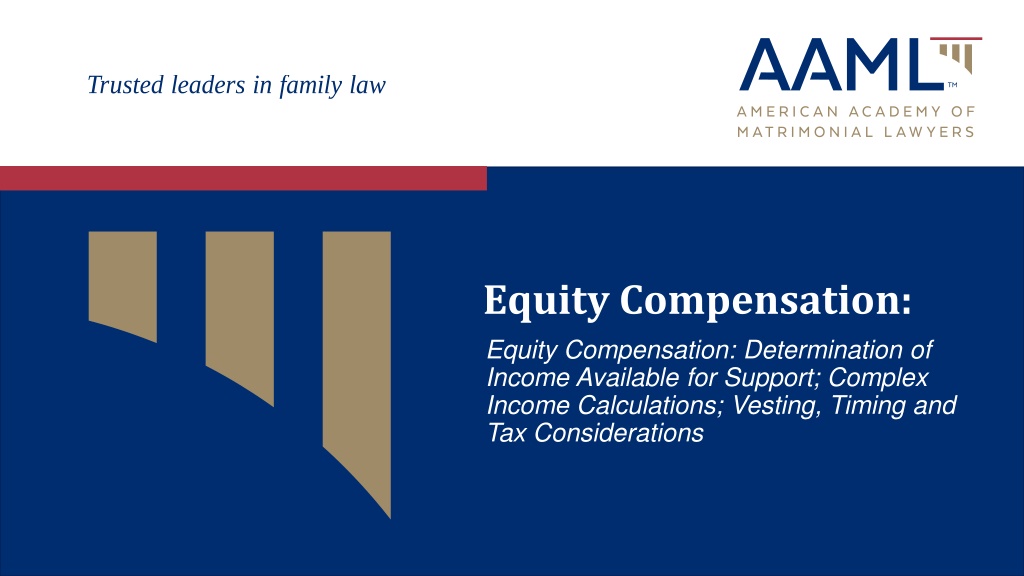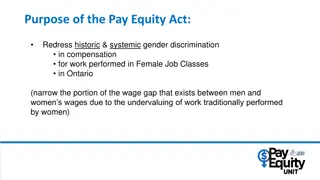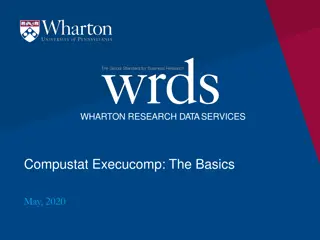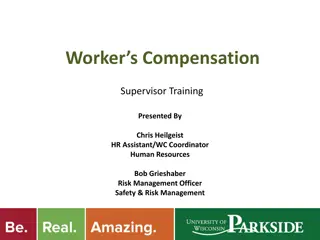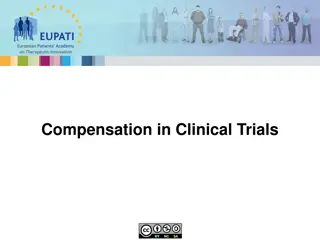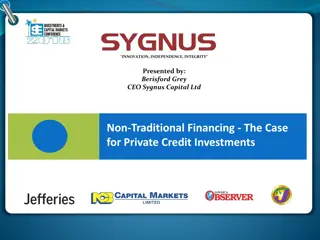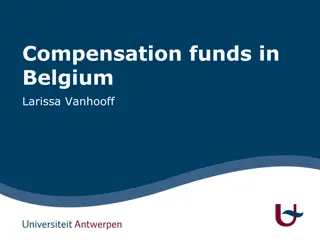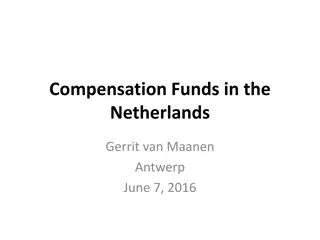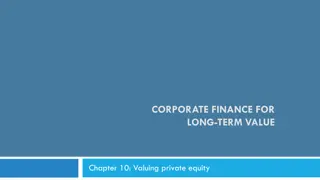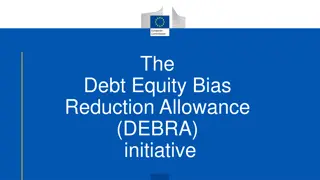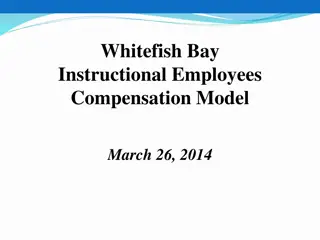Understanding Alternative Investments and Equity Compensation
Explore the world of alternative investments including private equity, venture capital, and hedge funds with a focus on equity compensation. Learn about complex income calculations, vesting, timing, and tax considerations. Discover how these unconventional assets with high return potential differ from traditional investments like cash, stocks, and bonds. Gain insights into the structure and compensation in alternative asset management companies, and understand the types of alternative investment funds available in the market.
Download Presentation

Please find below an Image/Link to download the presentation.
The content on the website is provided AS IS for your information and personal use only. It may not be sold, licensed, or shared on other websites without obtaining consent from the author. Download presentation by click this link. If you encounter any issues during the download, it is possible that the publisher has removed the file from their server.
E N D
Presentation Transcript
Equity Compensation: Equity Compensation: Determination of Income Available for Support; Complex Income Calculations; Vesting, Timing and Tax Considerations
Speakers Mich le Bissada, CFLS, AAML, IAFL Flicker, Kerin, Kruger & Bissada LLP www.fkkblaw.com Marie Ebersbacher, CPA CBIZ www.cbiz.com Alexandra Peais, CPA Gursey | Schneider, LLP www.gursey.com American Association of Matrimonial Lawyers: Mid-Year Meeting March 12-15, 2024 2 M ID-YEAR M EETING | 2024
STRUCTURE AND COMPENSATION IN ALTERNATIVE ASSET MANAGEMENT COMPANIES 3
What are Alternative Investments? Unconventional assets with potential for high return Not cash, stocks or bonds Complex in nature, limited regulation (usually private companies), usually limited liquidity Accredited investors and qualified clients are usually institutional investors i.e. pensions, endowments, and high net worth individuals 4 M ID-YEAR M EETING | 2024
What are Alternative Investments? (cont.) Types of Alternative Investments: Hedge Funds (HF) Private Equity (PE) Venture Capital (VC) Other (BDCs, real estate [including REITs], commodities, derivatives) [not discussed in this presentation] 5 M ID-YEAR M EETING | 2024
Types of Alternative Investment Funds PRIVATE EQUITY Closed-ended funds with 10- year terms Illiquid investments (generally 3-5 years) Invest in private companies, real estate, or vehicles holding debt VENTURE CAPITAL Closed-ended funds with 10- year terms Illiquid investments (generally 3-7+ years) Invest in startups mostly in tech and life sciences HEDGE FUND Open-ended funds without term limits Highly liquid, hedge risk, focus on ST profit Invest in marketable securities Aim to restructure company operations to sell for profit Aim to increase startup value until it gets acquired or IPO s Consistently invest and re- balance portfolio Controlling ownership may hire/fire/replace management Minority ownership partners act as advisors Do not get involved with management of portfolio investments LT commitment w/ drawdowns LT commitment w/ drawdowns ST commitment w/ upfront investment 6 M ID-YEAR M EETING | 2024
Typical Fund Structure General Partners $ $ Portfolio Company A 2-3% Mgmt Fee 20-30% Carry $ Limited Partners Portfolio Company B VC/PE Fund $ $ Portfolio Company C $ Portfolio Company D 7 M ID-YEAR M EETING | 2024
Typical Fund Structure (cont.) GPs generally manage multiple funds with overlapping investment periods Fund agreements dictate when new funds can be raised by GPs/investment manager (generally once current fund is at least 75% invested) Primary funds invest money put in by LPs into Portfolio Companies Affiliate or Side-Investment funds invest personal money put in by GPs and their friends into same Portfolio Companies alongside primary fund investment 8 M ID-YEAR M EETING | 2024
Primary Sources of Revenue for Alternative Asset Management Firms Management Fees: Charge for having the fund s assets professionally managed Used to cover operating expenses, after which can be distributed to the owners of the firm pro-rata Payments can occur quarterly, semi-annually or annually (set by LP agreement) 9 M ID-YEAR M EETING | 2024
Primary Sources of Revenue for Alternative Asset Management Firms (cont.) Management Fees (cont.): Generally, 2-3% of fund s capital commitments and can taper off over time (PEs / VCs) Provide base income for partners in the early days of the partnership As an advance against their carried interest Taxed at ordinary income tax rates 10 M ID-YEAR M EETING | 2024
Primary Sources of Revenue for Alternative Asset Management Firms (cont.) Performance Fees / Carried Interest: The portion of profits of the fund received by the fund managers/GPs when they generate positive returns For support purposes, because the timing and amount is variable, would use a bonus table. For HF, performance fees are generally 20% of a fund s increase in net asset value. Fund must meet investor hurdle rate and hit high-water mark for GPs to share in performance fees. 11 M ID-YEAR M EETING | 2024
Primary Sources of Revenue for Alternative Asset Management Firms (cont.) Performance Fees / Carried Interest (cont.): For PE and VC, generally referred to as carried interest (carry): Share of investment gains that go into GPs Only achieved when profits exceed the hurdle rate Carry can be clawed-back if the fund underperforms over time Typically, 20%-25% of fund s profit on sale of portfolio investments Taxed at capital gains tax rate even though this is a form of compensation 12 M ID-YEAR M EETING | 2024
Allocation of Profits between GPs and LPs Distribution Waterfall - dictates how distributions from sale of underlying investments are prioritized between fund GPs and LPs. American (deal by deal) waterfall European (whole fund/cumulative) waterfall 13 M ID-YEAR M EETING | 2024
Allocation of Profits between GPs and LPs (cont.) American (deal by deal) Waterfall: GP receives a percentage of profit distributions once capital contributions and preferred return on the current exited investment are returned to investors. Can be subject to clawback if later investments in the fund are sold at a loss 14 M ID-YEAR M EETING | 2024
Allocation of Profits between GPs and LPs (cont.) European (whole fund/cumulative) Waterfall: GP receives carry only after all capital contributions for both realized and unrealized investments, plus full preferred return on aggregate capital contributions of the fund are returned to investors No clawback issues because no carry distributed to GP until LPs receive 100% of capital plus hurdle rate 15 M ID-YEAR M EETING | 2024
Income Available for Support First step determine if the party is an: 1. Investor 2. Employee 3. Income Partner 4. Equity Partner / Owner 16 M ID-YEAR M EETING | 2024
Income Available For Support - Investor For Investors / Fund Co-investments: Passive investment that can be divided in kind Parties will receive a Schedule K-1 Return on investment generally reported on Schedule B (interest and dividends) and Schedule D (capital gains) of personal tax return No business valuation required 17 M ID-YEAR M EETING | 2024
Income Available For Support - Employee For Employees: Items reported on personal tax return: W-2 salary and bonus income Post separation earnings are separate property Any bonus should be based on a time rule Will receive a K-1 from the GP entity through which carried interest income will be received Carry generally reported on Schedule D Co-invest generally reported on Schedule B and Schedule D 18 M ID-YEAR M EETING | 2024
Income Available For Support Employee (cont.) For Employees: May need to perform a carry allocation (similar to stock option / RSU allocation) to determine character of income Generally, no management fees No business valuation required 19 M ID-YEAR M EETING | 2024
Income Available For Support Income Partner Income Partner (not an owner): Items reported on personal tax return: May receive a W-2 Will receive a K-1 from the GP entity through which carried interest income will be received Carry generally reported on Schedule D Co-invest generally reported on Schedule D May receive management fees reported on Schedule E 20 M ID-YEAR M EETING | 2024
Income Available For Support Income Partner (cont.) Income Partner (not an owner): May need to perform a carry allocation (similar to stock option / RSU allocation) to determine character of income No business valuation required 21 M ID-YEAR M EETING | 2024
Income Available For Support Owner / Equity Partner Owner / Equity Partner: Items reported on personal tax return: May receive a W-2 Will receive a K-1 from the GP entity through which carried interest income will be received Carry generally reported on Schedule D Co-invest generally reported on Schedule B and Schedule D Management fees generally reported on Schedule E 22 M ID-YEAR M EETING | 2024
Income Available For Support Owner / Equity Partner (cont.) Owner / Equity Partner: May need to perform a carry allocation (similar to stock option / RSU allocation) to determine character of income Business valuation potentially required 23 M ID-YEAR M EETING | 2024
Income Available For Support Recap Based on Position at Company 24 M ID-YEAR M EETING | 2024
STOCK STRUCTURE & COMPENSATION FOR START-UPS & OTHER PRIVATE & PUBLIC COMPANIES 25
Dual-Class Stock Structure Founders Management and Employees Investors Preferred Stock Common Stock Compensatory purpose -- Low price, Residual rights Investment purpose -- High price, Preferences and senior rights 26 M ID-YEAR M EETING | 2024
Types of Employee Equity Founders Stock Restricted Stock Stock Options: Incentive Stock Options ( ISOs ) Non-statutory (or Non-qualified ) Stock Options ( NSOs ) Other Types of Equity Compensation: Restricted Stock Units ( RSUs ) Performance Stock Units ( PSUs ) Stock Appreciation Rights ( SARs ) and Phantom Stock Profits Interests 27 M ID-YEAR M EETING | 2024
Stock Options - Generally What is an Option? A right to buy a fixed number of shares at a fixed price The right can be exercised at any time up to a specified expiration date No direct investment risk until exercised Usually, the number of shares that may be purchased upon exercise increases progressively or vests over time Generally, vesting is over four years with a 1-year Cliff 28 M ID-YEAR M EETING | 2024
Types of Stock Options Two types of Options: Incentive Stock Options or ISOs Created by Tax Code All other Options Non-statutory options, Non-qualified options, NSOs Difference is simply the tax treatment 29 M ID-YEAR M EETING | 2024
Types of Stock Options (cont.) Where to find NSO and ISO income on a Tax Return: NSOs: On the exercise date, the difference between the FMV and the strike price will show up as W-2 income at ordinary income tax rates. Upon sale, the difference between the FMV on exercise and FMV on sale shows up on the Schedule D of a tax return as capital gains or losses. ISOs: On the exercise date, the difference between the FMV and the strike price will show up on the Alternative Minimum Tax (AMT) Schedule on the tax return based on AMT tax rates. Upon sale, the difference between the FMV on exercise and FMV on sale shows up on the Schedule D of a tax return as capital gains or losses. 30 ANNUAL M EETING 2020
Types of Stock Options (cont.) Tax events in the life of an Option: 1. Grant of option 2. Exercise of option 3. Sale of shares received upon exercise of Option 31 M ID-YEAR M EETING | 2024
Types of Stock Options (cont.) Tax treatment of an NSO (default situation): 1. No tax at time of Grant: No tax event But exercise price must be at least equal to the Fair Market Value of the underlying Common Stock on the date of Grant 32 M ID-YEAR M EETING | 2024
Types of Stock Options (cont.) Tax treatment of an NSO (default situation) (cont.): 2. Taxed at time of Exercise: Taxed at Ordinary Income on the difference in value between Exercise Price and the FMV at time of Exercise. Subject to withholding and payroll taxes Optionee may have incur significant deduction from salary and may even have to write a check to cover withholding 33 M ID-YEAR M EETING | 2024
Types of Stock Options (cont.) Tax treatment of an NSO (default situation) (cont.): 3. Tax at time of Sale of Underlying Taxed at long-term Capital Gain on the difference in value between the Fair Market Value at Exercise and the FMV sale price, as long as the stock has been held for more than 1 year 34 M ID-YEAR M EETING | 2024
Types of Stock Options (cont.) Stock Options: ISOs and NSOs (cont.) One of the main differences is that ISOs can only be granted to employees, while NSOs can be granted to consultants, advisors, and directors as well as employees. If NSOs work for both, then why do most early-stage companies grant their employees equity options in the form of ISOs instead of NSOs? The answer: When it comes to tax treatment, ISOs have special advantages for employees. Because the exercise of NSOs is considered compensation, they result in a tax deduction for the issuing corporation the employer. 35 M ID-YEAR M EETING | 2024
Types of Stock Options (cont.) Incentive Stock Options ( ISOs ): Incentive stock options (ISOs) may only be offered to employees and expire 10 years after their issue. At most companies, they typically expire 90 days after employment is terminated, but some companies allow a longer window. ISOs almost always come with a vesting schedule. ISOs must be equal to the FMV at the date of the grant. Upon exercise, there are AMT tax liabilities incurred on the amount the FMV exceeded the option price at exercise. If exercising and selling simultaneously, the sale portion would show up on tax return Schedule D. ISOs stock, once exercised and held is taxable at the long-term capital gains rate if the stock is held for at least one year after exercise and the option grant date is over two years prior to the sale. 36 M ID-YEAR M EETING | 2024
Types of Stock Options (cont.) Non-statutory (or Non-qualified ) Stock Options ( NSOs ): NSOs do not qualify for ISO treatment, NSOs are the simpler of these two forms of stock options. They may include a vesting schedule or may not. 37 M ID-YEAR M EETING | 2024
Types of Stock Options (cont.) Non-statutory (or Non-qualified ) Stock Options ( NSOs ) (cont.): Taxation on NSOs first occurs when they are exercised and is based on the spread between the fair market value (FMV) of the stock at the time of purchase and the exercise price (also called strike price) of such options. The difference between the exercise price and FMV is treated as ordinary income tax, not capital gains. As such, they'll be taxed at the ordinary income tax rate. They'll also be charged employment taxes if they are an employee. To qualify for long-term capital gains treatment on the sale of stock purchased through an NSO is the same as listed above for an ISO. 38 M ID-YEAR M EETING | 2024
Other Forms of Equity Compensation Restricted Stock Units ( RSUs ): A company's promise to give a specific number of shares of stock or cash equivalent to an employee at a future date, once vested. Restricted Stock is any stock that is subject to a right of repurchase upon termination of employment prior to vesting. Generally, the company can repurchase the shares at the original purchase price [Notice the similarity - Founders Stock is really just a special case of Restricted Stock.] Same as Restricted Stock Awards except the shares are not issued until they are vested. 39 M ID-YEAR M EETING | 2024
Other Forms of Equity Compensation (cont.) Restricted Stock Units ( RSUs ): In public companies, RSUs are generally issued for no consideration and the employee makes no payment for the stock. In private companies, RSUs are generally purchased by the employee at a price equal to current FMV. 40 M ID-YEAR M EETING | 2024
Other Forms of Equity Compensation (cont.) Restricted Stock Units ( RSUs ): Vesting is typically based simply on time. Sometimes it is tied to performance metrics, usually in public companies The circumstances of termination generally don t matter. Vesting stops upon any termination. Vesting may be accelerated for: Acquisition of Company ( Single Trigger ) Termination after acquisition of Company ( Double Trigger ). 41 M ID-YEAR M EETING | 2024
Other Forms of Equity Compensation (cont.) Restricted Stock Units ( RSUs ): RSUs are assigned a fair market value when they vest. Upon vesting, they are considered income, and a portion of the shares are withheld to pay income taxes. The employee receives the remaining shares and can sell them at their discretion. The taxable income is the FMV of the shares at vesting. The income is subject to federal and employment tax (Social Security and Medicare) and any state and local tax. Most companies do not withhold enough to cover all the income taxes on RSU compensation, as employees generally are in a higher tax bracket than what the company withholds, so employees generally still owe additional taxes on the RSUs in that tax year the RSUs vested. 42 M ID-YEAR M EETING | 2024
Other Forms of Equity Compensation (cont.) Restricted Stock Units ( RSUs ): Recipients can choose to be taxed immediately on difference at time of purchase by filing 83(b) Election The employee receiving the RSUs must file the 83(b) Election with IRS within 30 days of receiving the stock. NO EXCEPTIONS Generally, an 83(b) Election is always filed where Restricted Stock was purchased. Compare that an 83(b) Election is usually never filed where the RSUs were issued to the employee for no payment. 43 M ID-YEAR M EETING | 2024
Other Forms of Equity Compensation (cont.) Performance Stock Units ( PSUs ): PSUs are a company's promise to give a targeted number of shares of stock or cash equivalent to an employee at a future time, once vested. The actual number of shares given will vary based on performance as measured against the defined goals. Same as RSUs, except vesting based upon performance metrics rather than merely time. The Metrics may be Company performance, individual performance or a combination of both. 44 M ID-YEAR M EETING | 2024
Other Forms of Equity Compensation (cont.) Performance Stock Units ( PSUs ): Tax treatment of a PSU (default situation): Employees granted PSUs are not required to pay income taxes on the PSUs on the Grant Date. PSUs are taxed at ordinary income tax rates when the underlying Shares are delivered to the employee. The amount of ordinary income recognized will be the value of the PSUs when vested. 45 M ID-YEAR M EETING | 2024
Other Forms of Equity Compensation (cont.) Stock Appreciation Rights ( SARs ) and Phantom Stock: These are methods for companies to give their management or employees a cash bonus if the company performs well financially. PLEASE REFER TO SUPPLEMENTAL MATERIALS FOR ADDITIONAL INFORMATION ON THESE TYPES OF COMPENSATION 46 ANNUAL M EETING 2020
EQUITY COMPENSATION: VESTING CONSIDERATIONS 47
Performance Fees/Carried Interest Performance fees/carried interest percentage participation is generally set at the beginning of a new fund Increases and/or decreases in percentage participation during the life of the fund based on performance on particular investments (employees & owners), new employees admitted, employees leaving the firm 48 M ID-YEAR M EETING | 2024
Performance Fees/Carried Interest - Vesting Vesting at fund level vs. portfolio company level Fund level over life of fund, generally not ratable (7-10 years) Portfolio company level over life of portfolio company investment, generally ratable (3-4 years) Different than vesting of stock compensation in that employees/owners receive 100% of the performance/carried interest granted to them unless they leave the firm i.e. divestiture schedule rather than vesting schedule 49 M ID-YEAR M EETING | 2024
Typical Four-Year Vesting for RSUs and Stock Options Cliff vesting* Vesting* of remaining 75,000 shares at 1/36th per month (2,083 shares) 25,000 shares vested 50,000 shares vested 75,000 shares vested Fully vested 1 year 2 year 3 year 4 year *Unvested shares subject to company right to repurchase at cost 50 M ID-YEAR M EETING | 2024
